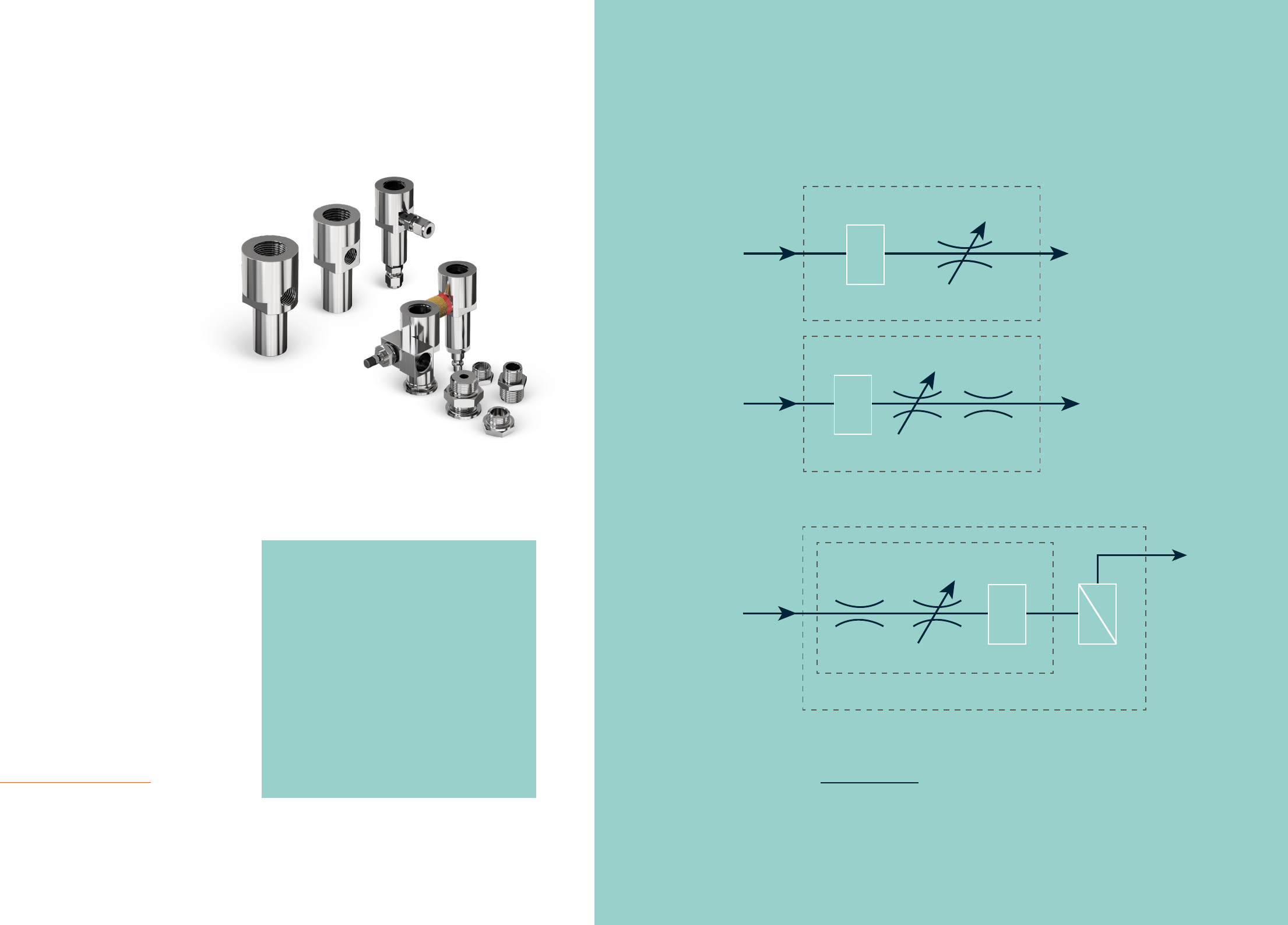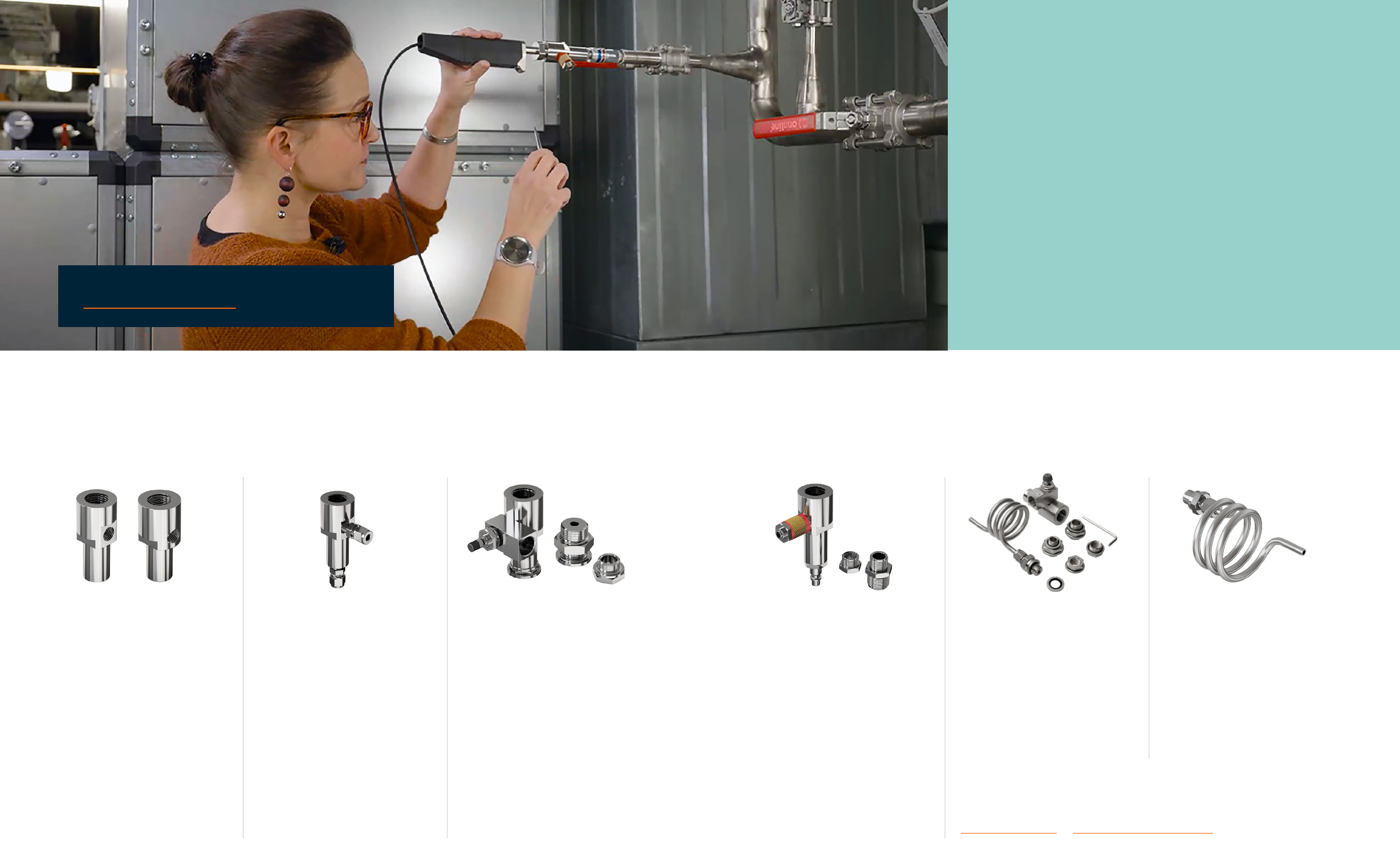
Compressed
air dew point
sampling
Application Note

Measurement in the process pressure
Measurement in the atmospheric pressure
DSC74B
DSC74C
DSC74
DSC74B
Diffusion coil
Removable
flowlimiter
Sample gas
inlet
Valve
Sample gas
outlet
Chamber
for DMP74
Sample gas
inlet
Chamber
for DMP74
Valve
Sample gas
outlet
Removable
flowlimiter
Sample gas
inlet
Chamber
for DMP74
Valve
Sample gas
outlet
»
See technical note Dewpoint sampling cells
for DRYCAP® products for details
Why Vaisala?
Vaisala is a global leader in measurement
instruments and intelligence for climate
action. We equip our customers with devices
and data to improve resource efficiency, drive
energy transition, and care for the safety and
well-being of people and societies worldwide.
With almost 90 years of innovation and
expertise, we employ a team of over 2,300
experts committed to taking every measure
for the planet.
Sampling is needed when direct measurement of
the air is undesirable or is simply not feasible. This
may be due to a high process temperature, the
need to protect the sensor from water spikes, the
added convenience of installing and removing the
instrument from a pressurized process without
shutting down the line or wanting to make the
measurement in a more convenient location.
To get a representative sample of the process
gas and avoid potential sources of error caused
by incorrect sampling practices, the following
aspects should be considered.
»
Visit vaisala.com/compressedair for more
information about the products.
Compressed air
dew point sampling
21

01
Pressure
It is important to keep in mind that changing the
gas pressure changes the dew point temperature
of the gas. If the sensor is at a different pressure
than the process itself, an error of several tens of
degrees dew point may be apparent. Generally,
the measurement should be taken at the actual
system pressure to avoid pressure drops in the
sampling system. Exceptions can sometimes be
made when standards require reporting the dew
point at ambient pressure, thus excluding the
effect of pressure fluctuations.
02
Condensing water
When the need for sampling is due to a high
process gas temperature prohibiting direct
measurement, it is important to ensure that the
dew point level of the process is lower than the
ambient temperature to which the sample gas is
cooled in the sampling line. This prevents water
vapor in the sample from reaching saturation
causing liquid water to form in the sample line.
In cases where the dew point is higher
than ambient temperature, either a direct
measurement or a heated sampling line
is required.
03
Leak tightness
& materials
Due to the very low level of humidity typically
found in compressed air and gas systems, dew
point measurements are highly sensitive to even
the smallest leaks in the system. Consequently,
the importance of having a leak-tight sampling
system is critical. All connections should be tight
and sealed correctly. For tapered threads like NPT,
use of Teflon tape is recommended. For straight
thread connections such as G 1/2”, the sealing
washer provided with the instrument should be
installed between the probe and the sample cell.
Careful consideration should always be given to
the sampling system’s material of construction
since water vapor diffusion through the pipe
or tubing walls can occur. The piping should
preferably be made of metal, e.g., stainless steel
with a good surface finish. Hygroscopic material
such as rubber hose and plastics is undesirable
and should be avoided. PTFE or Teflon is one
exception that is a rather vapor tight plastic and
can be used down to a dew point level of about –
40 °C (-40 °F).
Sample tubing should be as short in length as
possible and “dead ends” should be avoided. Also
minimizing the number of connections helps in
avoiding leaks. If possible, prepare the sampling
system for the measurement by purging it with
the dry process gas sufficiently to ensure a faster
stabilization and response time.
04
Flow rate
considerations
Stagnant air can be a problem for a few reasons:
1. A representative sample of the process air may
not be obtained.
2. Response time may be dramatically impaired.
3. The risk of ambient air leaking or diffusing
through sampling materials increases.
4. Back diffusion of ambient water vapor through
the outlet port of the sample cell can occur.
•
Using a dew point sensor that is not dependent
on flow rate is strongly recommended. Although
higher flow rates generally improve the sensor
response time, flows of 1-2 l/min (0.035-
0.7 ft3/min) are typically enough for high-
quality sensors.
43

DMT242SC & SC-025NPT
basic models
Basic sample cells consisting of just the main
sampling body.
Suitable for users requiring only a
sample cell for a probe and doing further
assembly themselves
(piping into inlet and outlet, valves and
possible flow meter).
The inlet and outlet are female threaded
sample connectors.
DMT242SC: inlet G3/8” ISO, outlet G1/4” ISO
SC-025NPT: inlet 1/4”NPT, outlet 1/4”NPT
DSC74
quick connector, leak screw and
thread adapters
Contains an adjustable leak screw that
maintains the compressed air system
pressure at the cell (the leak screw is
opened and closed with a screwdriver
and should be turned 1/2 turn which
approximates a 1 l/min flow rate.)
Comes with a quick connector that fits
industry standard compressed air line
connectors. This allows for easy installation
and detachment of the dew point
transmitter without having to shut down
the process.
Alternative ways to connect are through
the two different thread adapters - R3/8”
to R1/2” and G3/8” to G1/4” ISO – that are
supplied with each DSC74 cell.
DMT242SC2
Swagelok® connectors for 1/4” tubing
Same body as DMT242SC, but with welded
Swagelok® connectors at both the inlet and
outlet that fit directly to 1/4” tubing.
To fit 6 mm tubing to the connectors,
an adapter such as Swagelok® Reducer
SS-6M0-R-4 (not supplied by Vaisala) can
be used.
Can be used with DMCOIL - Shown below.
DSC74CSP
two-pressure sampling cell with coil
Designed for the most critical
measurements at atmospheric pressure
The diffusion coil is connected to the
sampling cell outlet to protect the sensor
from ambient humidity disturbing
the measurement
Used with a ISO1/2” Swagelok connector
DSC74B
two-pressure model for elevated and
atmospheric pressure
Includes inlet/outlet valve and inlet/outlet
connection for gas tubing.
Limits flow rate with a fixed leak screw.
Flow is optimized for pressures 3 ... 10 bar.
Fixed leak screw eliminates the risk
of opening the screw completely and
emptying a gas vessel.
Maximum flow can be increased, if needed,
by removing the leak screw and adjusting
the flow manually with the valve.
Reducing parts supplied (G3/8” -G1/2” or
G3/8” - G1/4”) on the outlet side help to
protect the sensor from ambient humidity
leaking in.
DMCOIL
stainless steel (aisi316l)
Coil accessory – DMT242SC2 required.
Used as a cooling coil in high
temperature gas processes to cool gas
temperature down to a suitable level for
measurement sensors.
For applications where gas pressure is
reduced to ambient pressure prior the
sample cell, it can act as venting coil in gas
outlet to prevent ambient humidity from
disturbing low dew point measurement.
Indigo-compatible probes
and sample cells
Our sample cells are compatible with several of our dew
point measurement instruments that are meant for
different purposes:
• Spot-checking: Vaisala Indigo80 handheld indicator in
combination with DMP80
• Inline process measurement: Vaisala DRYCAP
®
dew point
probe DMP7 (requires SWG12ISO12)
• Original equipment manufacturing: Vaisala DRYCAP
®
dew point probes DMT132, DMT143, DMT143L, DPT146,
and DMT152
• The sample cells can also be used with various previous
generation Vaisala DRYCAP
®
dew point instruments
such as Vaisala DRYCAP
®
dew point instruments DM70,
DMT142, DMT242, DMT347 (SWG12ISO12 required),
and DMT348.
05
»
Order sample cells, spare parts and selected products via
store.vaisala.com or contact our sales experts.
»
See how to spot-check a compressed air system:
vaisala.com/compressedair
65

vaisala.com
This material is subject to copyright protection, with all copyrights retained by Vaisala and its
individual partners. All rights reserved. Any logos and/or product names are trademarks of Vaisala
or its individual partners. The reproduction, transfer, distribution or storage of information
contained in this brochure in any form without the prior written consent of Vaisala is strictly
prohibited. All specifications — technical included — are subject to change without notice.
Ref. B211229EN-E ©Vaisala 2024
